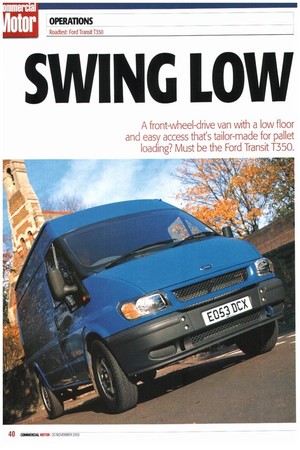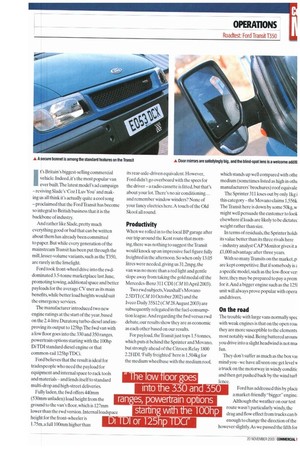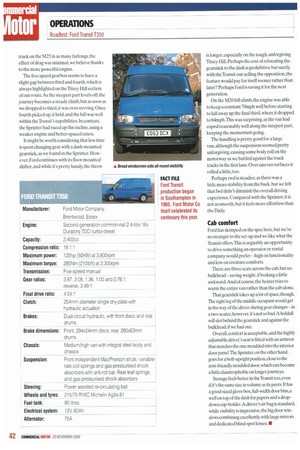Si NG LOW
Page 40

Page 41

Page 42

If you've noticed an error in this article please click here to report it so we can fix it.
A front-wheel-drive van with a low floor and easy access that's tailor-made for pallet loading? Must be the Ford Transit 1350.
It's Britain's biggest-selling commercial vehicle. Indeed.it's the most popular van ever built:The latest model's ad campaign — reviving Slade's 'Coz I Luv You' and making us all think it's actually quite a cool song — proclaimed that the Ford Transit has become so integral to British business that it is the backbone of industry.
And rather like Slade. pretty much everything good or bad that can be written about them has already been committed to paper. But while every generation of the mainstream Transit has been put through the mill ,lesser-volume variants, such as the 1'350, are rarely in the limelight.
Ford took front-wheel drive into the rwddominated 3.5-tonne marketplace last June, promoting towing, additional space and better payloads for the average CV user as its main benefits, while better load heights would suit the emergency services.
The manufacturer introduced two new engine ratings at the start of the year, based on the 2.4-litre Duratorq turbo-diesel and improving its output to 125hp.The fwd van with a low floor goes into the 330 and 350 ranges. powertrain options starting with the 100hp Di TDI standard diesel engine or that common-rail 125hp TDCi.
Ford believes that the result is ideal for tradespeople who need the payload for equipment and internal space to rack tools and materials — and lends itself to standard multi-drop and high-street deliveries.
Fully laden, the fwd offers 440mm (530mm unladen) load height from the ground to the van's floor, which is 127mm lower than the rwd version. Internal loadspace height for the front-wheeler is 1.75m, a full 1 00mm higher than its rear-axle-driven equivalent. However. Ford didn't go overboard with the specs for the driver —a radio cassette is fitted, but that's about your lot.There's no air conditioning... and remember window winders? None of your fancy electrics here.A touch of the Old Skool all round.
Productivity When we rolled in to the local BP garage after our trip around the Kent route that morning, there was nothing to suggest the Transit would knock up an impressive fuel figure fully freighted in the afternoon. So when only 13.05 litres were needed, giving us 312mpg, the van was no more than a red light and gentle slope away from taking the gold medal off the Mercedes-Benz 311 CDI (CM 10Apr11 2003).
Tivo rwd subjects, Vauxhall's Movano 2.5DTI (CM 10 October 2002) and the Iveco Daily 35S12 (CM28 August 2003) are subsequently relegated in the fuel-consumption league.And regarding the fwd versus rwd debate, our results show they are as economic as each other based on our results.
For payload, the Transit just tops 1.5 tonnes, which puts it behind the Sprinter and Movano, but strongly ahead of the Citroen Relay 1800 2.2111D1. `Fully freighted' here is 1,504kg for the medium wheelbase with the medium roof, which stands up well compared with othe medium (sometimes listed as high in othc manufacturers' brochures) roof equivale The Sprinter 311 loses out by only lkg i this category — the Movano claims 1,556k The Transit here is down by some 50kg,w might well persuade the customer to look elsewhere if loads are likely to be dictate( weight rather than size.
In terms of residuals, the Sprinter holds its value better than its three rivals here — industry analyst CAP Monitor gives it a £1,000 advantage after three years.
With so many Transits on the market,p arc kept competitive. But if somebody is a a specific model,such as the low-floor ven here. they may be prepared to pay a prem for it.And a bigger engine such as the 1251 unit will always prove popular with opera and drivers.
On the road The trouble with large vans normally spec with weak engines is that on the open roa( they are more susceptible to the elements most notably wind. Being battered arounc you drive into a slight headwind is not mu' fun.
They don't suffer as much as the box vai mind you we have all seen one get level vi a truck on the motorway in windy conditic and then get pushed back by the wind turf lenee.
Ford has addressed this by placii a market-friendly "bigger" engine. Although the weather on our test route wasn't particularly windy, the drag and flow effect from trucks can b enough to change the direction of the however slightly. As we passed the fifth for truck on the M25 in as many furlongs, the effect of drag was minimal, we believe thanks to the more powerful engine.
The five-speed gearbox seems to have a slight gap between third and fourth, which is always highlighted on the Titsey Hill section of our route. As the steepest part levels off, the journey becomes a steady climb, but as soon as we dropped to third, it was over-revving. Once fourth picked up. it held, and the hill was well within the Transit's capabilities. In contrast. the Sprinter had raced up this incline, using a weaker engine and better-spaced ratios.
It might be worth considering that less time is spent changing gear with a dash-mounted gearstick, as we found in the Sprinter. However, Ford continues with its floor-mounted shifter, and while it's pretty handy, the throw is longer, especially on the tough, unforgiving 'Titsey Hill. Perhaps the cost of relocating the gearstick to the dash is prohibitive but surely, with the Transit out-selling the opposition,the feature would pay for itself sooner rather than later? Perhaps Ford is saving it for the next generation.
On the M20 hill climb, the engine was able to keep a constant 70mph well before starting to fall away up the final third, where it dropped to 64mph.This was surprising, as the van had coped reasonably well along the steepest part, keeping the momentum going.
The handling is pretty good for a large van, although the suspension seemed pretty unforgiving, causing some body roll on the motorway as we battled against the truck tracks in the first lane. Over uneven surfaces it rolled a little, too.
Perhaps rwd is steadier, as there was a little more stability from the back, but we felt that fwd didn't diminish the overall driving experience. Compared with the Sprinter, it is not as smooth, but it feels more effortless than the Daily.
Cab comfort
Ford has skimped on the spec here,but we're no stranger to the set-up and we like what the Transit offers.This is arguably an opportunity to drive something an operator or rental company would prefer — high on functionality and low on creature comforts.
There are three seats across the cab, but no bulkhead —saving weight, if looking a little awkward. And of course, the heater tries to warm the entire van rather than the cab alone.
That gearstick takes up a lot of space, though. The right leg of the middle occupant would get in the way of the driver during gear changes —in a two-seater.however, it's not so bad.A holdall will slot behind the gearstick and against the bulkhead.if we had one.
Overall,comfort is acceptable. and the highly adjustable driver's seat is fitted with an armrest that matches the one moulded into the interior door panel.The Sprinter, on the other hand, goes for a bolt-upright position,close to the arm-friendly moulded door,which can become a little claustrophobic on longer journeys.
Storage feels better in thellansit too, even if it's the same size in volume as its peers. It has a good-sized glove box, full-width door bins,a well on top of the dash for papers and a dropdown cup-holder.A driver's air bag is standard. while visibility is impressive, the big door windows combining excellently with large mirrors and dedicated blind-spot lenses. •
































































































































































































